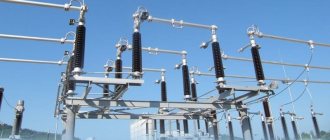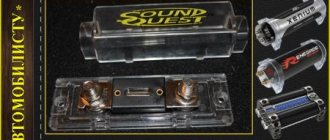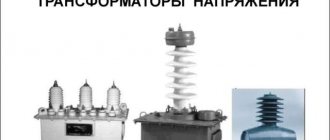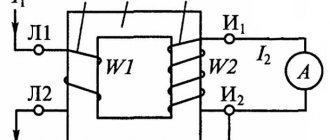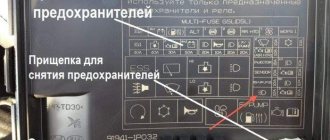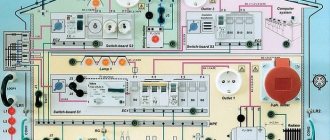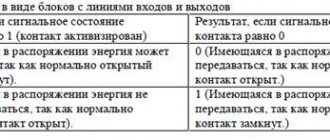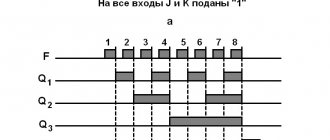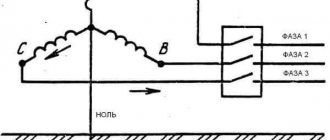Fuses PKT and PKN
High-voltage fuses of the PKT series are intended for use in three-phase alternating current networks with voltage from 6 to 35 kV, frequency 50 and 60 Hz to protect power transformers, overhead and cable lines from overcurrents during overloads and short circuits. High-voltage fuses of the PKN series are designed to protect voltage transformers in three-phase alternating current networks with voltage from 6 to 35 kV, frequency 50 and 60 Hz. PKN001-10 type fuses can be used to protect power transformers with a power of 1.25 kVA with a rated voltage of 6 kV. The permissible current value in long-term mode for PKN001 fuses should not be more than 0.5A.
Decoding PCT
PKT 101-10-16-20 U1:
P - fuse; K - with quartz filler; T - for power transformers; 1 - single-pole, with operation indicator; 01 — contact design; 10 - rated voltage in kilovolts; 16 - rated fuse current in amperes; 20 - rated shutdown current in kiloamperes; U - climatic version; 1 — accommodation category.
PC Х-ХХХ-XYZ У1:
P - fuse; K - with quartz filler; X - N - for protecting voltage transformers; E - for the protection of power electrical circuits of excavators and mobile auto power stations for rated voltages of 6, 10 kV, EN - designed to protect voltage transformers of excavators and mobile auto power stations for rated voltages of 6, 10 kV. X - rated voltage, kV (corresponds to the highest operating voltage of the fuse): 6 (7.2); 10 (12); 35 (40.5); Y - rated current, A: 2; 3.2; 5; 8; 10; 16; 20; 25; 31.5; 40; 50; 80; 100; 160; 200; 315; Z is the rated breaking current in kiloamperes; U - climatic version; 1 — accommodation category.
Complete set of fuse PKT
Fuse PKT 101, PKT 102, PKT 103, PKT 104 consists of the following elements and is supplied disassembled:
— cartridge (replaceable element) PT 1.1, PT 1.2, PT 1.3, PT 1.4 – 1 pc.
— contact (other names: sponge, tweezers, holder) K01, K02, K03, K04 – 2 pcs.
— support insulator IORP-10-06 (version U3) or S4-80 (version U1) – 2 pcs (insulators are installed on a special base or directly on the structural elements of the switchgear).
Design and principle of operation of the PKT fuse
The fuse holder consists of a porcelain tube 3 filled with quartz sand, which is reinforced with brass caps 2 with covers 1. Fuse links are made of silver-plated copper wire. At a rated current of up to 7.5 A, several parallel inserts 5 are used, wound on a ribbed ceramic core (Fig. a). At high currents, several spiral inserts are installed (Fig. b).
Fuse holders of PKT type: a - for rated currents up to 7.5 A; b - for rated currents 10...400 A; 1 - cover; 2 — brass cap; 3 - porcelain tube; 4 - quartz sand; 5 - fuse links; 6 — operation indicator; 7 - spring
Cutting off the current in the PT cartridge during a short circuit occurs due to the intense process of deionization of the arc, which occurs in the places where the fuse link lies, in the microscopic gaps between grains of sand of the quartz filler.
The contact of the PKT 101 fuses consists of contact jaws 1, covered by a steel bracket 2, which provides the necessary contact pressure; contact terminal, consisting of a table strip 3, with a copper patch strip 4, and limiters 5, ensuring installation of the cartridge in the correct position and preventing it from slipping out of the contacts during single shocks.
The fuse contact PKT 102 (K 02-10) differs from the contact K 01-10 in width. The fuse contact PKT 103 (K 03-10), in comparison with K 02-10, has one (more massive) contact jaw and is additionally equipped with a lock in the form of a hinged spring bracket that prevents the cartridge from falling out under the action of electrodynamic forces or single shocks. The fuse contact of the PKT 104 series (K 04-10) is made of two contacts from the PKT 103 series fuse, assembled without steel or copper strips and installed on the contact terminal, which is a massive plate.
PKT 101 fuses of placement category 1 differ from fuses of the same placement category 3 in the form of supporting insulators and the presence in the cartridge of additional parts that seal the internal cavity of the cartridge.
Characteristics of PT cartridges
| Type of cartridge | Unom., kV | Inom., A | Ioff, kA | Chuck length, mm | Cap diameter, mm |
| PT 1.1 | 10 | 2; 3,2; 5; 8; 10; 16; 20; 31,5 | 12,5; 31,5 | 412 | 55 |
| PT 1.1 | 6 | 2; 3,2; 5; 8; 10; 16; 20; 31,5 | 20; 40 | 312 | 55 |
| PT 1.2 | 10 | 31,5; 40; 50 | 12,5; 31,5 | 464 | 72 |
| PT 1.2 | 6 | 31,5; 40; 50; 80 | 20; 31,5 | 364 | 72 |
| PT 1.3 | 10 | 80; 100 | 12,5; 20; 31,5 | 464 | 72 |
| PT 1.3 | 6 | 80; 100; 160 | 20; 31,5 | 364 | 72 |
| PT 1.4 | 10 | 100; 160; 200 | 12,5; 20; 31,5 | 464 | 72 |
| PT 1.4 | 6 | 160; 200; 315 | 20; 31,5 | 364 | 72 |
Technical characteristics of PKT 101, PKT 102, PKT 103, PKT 104
Technical characteristics of PKN 001
Overall, installation and connection dimensions of fuses PKT-101, PKT-102, PKN, weight of fuses and cartridges
Overall, installation and connection dimensions of fuses PKT-103, PKT-104, weight of fuses and cartridges
General description of devices
It is worth saying that high-voltage fuses start from 1 kV. They protect equipment from defects such as short circuit current and unacceptable overload currents.
You may be interested in:Coffee maker Scarlett SC-037: description, specifications, customer reviews
These devices have several basic technical parameters by which they are selected. Among them are the rated voltage, rated continuous current and the dependence of the melting time on the current value. There is another parameter, which is often called breaking capacity. However, to characterize it, a characteristic such as rated switched power is used. 10 kV high-voltage fuses, like any other, contain a fuse link that is connected to the protected circuit in a series manner.
You may be interested in: Flexible neon cord: description and application
Border and maximum switchable currents
There are fuse links in high-voltage equipment that will burn out the moment their maximum temperature is reached. Most often, such protective devices are called border protection devices. Naturally, if the boundary current is close in value to the rated value or slightly greater than it, then in this case the fuse element is able to operate normally at its parameters.
There is another important parameter, which is called the maximum cut-off current. In this case, we are talking about the maximum current value that the selected fuse element can turn off.
It is important to know here that this value should be either equal to or slightly greater in value than the maximum possible short circuit current in the protected circuit. If you choose the wrong fuse based on this parameter, then the duration of the arc may be too long, which will lead to the destruction of the cartridge of the device itself, and not just the fusible element.
Types of microwave fuses
There are three different types of fuses in a microwave oven - one mains fuse and two high-voltage ones.
A high-voltage fuse for a microwave oven serves as protection for an element such as a magnetron. This is a high-voltage transformer that needs protection. The protective element itself is located structurally next to it, but if you pay attention to the diagram, you will notice that it opens the circuit between the input and output of the high-voltage unit.
As for the second fuse of a similar type, it is available only in those microwave ovens that have an electronic control panel. In this case, such a panel should be powered by a small low-power transformer. He will be responsible for converting the electrical current from the home network into the voltage required for the panel to operate.
Advantages of using the PKT series
There are several main advantages why the PCT series is popular. This includes, for example, the fact that the cartridge is made of high-quality and heat-resistant porcelain, which is additionally coated with a waterproof glaze. Here we use quartz sand, which is characterized by a high degree of purification. In addition, a special filling technique is used to achieve a very dense placement of sand grains. This is important because this factor ensures very effective arc extinguishing.
Finally, it is worth adding that the dimensions of a 10 kV high-voltage fuse refer to the dimensions of its holder in terms of length and diameter.
Source
Burning time
The burnout time of a given fuse link in 10 kV high-voltage fuses is a very important indicator. This parameter depends on how much current will flow through the fuse. Most often, the obtained value is called either the protective or current characteristics of the fuse-link. From this value you can determine how long it will take the device to turn off the circuit at the selected current value. Using special calculations, it will also be possible to determine the parameters of selective operation of fuses and relay protection of an electrical installation.
It is important to know here that the current that can melt a fusible element also depends on the design of the device, on the physical data of the element itself, for example, on the material, shape, length, cross-section. Many people do not know, but in this case the ambient temperature will also make a significant contribution. It is worth adding that a high-voltage fuse of 10,000 volts can be operated for quite a long time if either its rated or a lower electric current passes through its fuse element. During the conduction of electric current of the operating value, the insert will also heat up, but at the same time it does not lose its shape and structure at all.
Current limiting fuse
Those devices that are capable of sharply reducing the current in a circuit if a short circuit occurs are called current-limiting. When too high a current begins to pass through this fuse-link, which occurs only during a short circuit, or a prolonged overload with increased current occurs, it begins to melt. First it turns into a liquid, and then into a gaseous state. At the moment of melting of this metal insert, an arc will form at the 10 kV high-voltage fuse, just like in any other similar device.
The duration of this arc, as well as the time required to extinguish it inside the fuse, will depend on the design of the device itself, as well as on the type of fuse link. Only after the arc has completely extinguished will the circuit finally break.
You may be interested in:How AirPods work: description and characteristics
Microwave fuses
A high-voltage fuse for a microwave is as necessary as in any other network with expensive equipment. Microwave ovens are quite complex household devices in their design. The metal structure of the fuse for this device is as follows: a metal thread in the role of a fusible insert, which is located in a glass flask, as well as special tips at the ends of the flask to make it convenient to install the protective device. If the current value reaches the nominal value, the metal thread begins to heat up. The heating rate increases with increasing current flow. When the filament temperature reaches a certain value, the filament breaks, causing the entire device to be de-energized.
PC devices
Most often, high-voltage 10 kV PKT fuses are used in closed switchgear designed for the same voltage. PC devices can also be used for the same purposes. For example, the PC series are fuses that belong to current-limiting devices.
The markings of these devices are disclosed as follows. PC series means it is a type of fuse with fine grain quartz filler. The letter "T" indicates that the device is intended to protect power transformers. It turns out that high-voltage PKT fuses are fine-grained quartz fillers designed to protect power transformers up to 10 kV.
